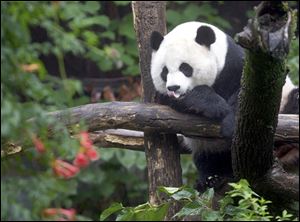
National Zoo says female giant panda Mei Xiang has experienced a false pregnancy
7/22/2011
Mei Xiang sleeps in a tree in the panda enclosure at the National Zoo in Washington in this 2007 file photo.
WASHINGTON — Giant panda Mei Xiang kept people guessing for months, but National Zoo veterinarians determined Friday that she had failed to become pregnant for the fifth year in a row even after a Chinese breeding expert tried to help her conceive.
The veterinarians announced Mei Xiang (may-SHONG) was experiencing a pseudopregnancy over the past several months, which means she ovulated but did not conceive. Animal keepers had been closely watching her behavior and monitoring her hormone levels in recent months because she had been eating less, staying in her den and cradling objects the way she did before she gave birth once before.
In January, the Smithsonian Institution signed new five-year, $2.5 million agreement with the Chinese to keep the beloved pandas in Washington. The agreement, announced during a lavish state visit by China's president, came with the caveat that one or both of the pandas could be switched out for others from China during the five-year span if they aren't able to breed.
It's difficult to determine when a panda is pregnant. Scientists say panda fetuses don't start developing until the final weeks of a gestation period. Mei Xiang stopped allowing animal keepers to perform ultrasound exams on her in early July.
The zoo was hopeful, though, because a Chinese panda breeding expert helped zoo scientists artificially inseminate Mei Xiang in January. She and male panda Tian Tian (tee-YEN tee-YEN) had attempted to mate but weren't successful. Their only other cub, Tai Shan, was born July 9, 2005, and has since been sent to China.
Pandas have a long history intertwined with diplomacy between Washington and Beijing. The first panda couple, Ling-Ling and Hsing-Hsing, arrived in 1972 as a gift to the American people after President Richard Nixon's historic visit to China. Ling-Ling and Hsing-Hsing produced five cubs, but none survived.